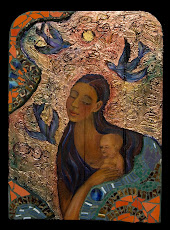Creating the monoprint is a sensual process that by its nature engages images. I begin with a glass plate that I then finger paint an image onto it. I refine the image with a variety of tools like sticks, wedges and other edge tools. When the image looks done, I put it on the steel bed of the printing press and turn the crank handle, pressing the image onto a sheet of paper. After that I hang the image to dry. Later I go back into the image with drawing tools to pick up lines, shapes and forms that enrich the image.
When I finished my part, I gave the image to Cindy and she refined areas important to her, and the piece became entirely different. Read what Cindy had to say about her part of the collaborative experience:
If I Were a Nahua Poet/ Si yo fuera poeta Nahua
This broadside is a collaborative project involving three artists:
poet Cindy Williams Gutiérrez, translator and poet Ángel Fuentes,
and printmaker Cristina Acosta.
The original poem was written by Gutiérrez in English with
Nahuatl code-switching in 2008. In January of 2010, the poem was
translated into Spanish by Yucatecan poet Fuentes (with the author)
in a translation workshop led by Professor Pedro Serrano of la
Universidad Nacional Autónoma de México (UNAM). Both the
original and the translation were published online in UNAM’s
Periódico de poesía in April of this year.
This August, visual artist Acosta responded to the poem by creating a collage of two original monoprints encircled by the original poem and its translation (in her handwriting). In the spirit of collaboration, Acosta left the broadside with Gutiérrez, inviting her to alter it as she felt moved to do so.
Note: This project evolved from el Grupo de ’08, a collaborative artists’ salon
founded by Gutiérrez in 2008 to inspire collaboration among Northwest writers,
musicians, and visual artists. The salon is inspired by Federico García Lorca and
named for the multi-disciplinary group of Spanish artists to which Lorca belonged,
la Generación de ’27. Greg Simon, a noted Lorca translator, is a core member and
a continual source of inspiration for the Northwest group.
__________________________________________________________
Artist Statement
Cindy Williams Gutiérrez
Duality inspires my work. I write to wrestle with contradiction, to explore the connections among the disparate—to experience opposing ideas, emotions, people, places, even languages in close proximity.
In this piece, I was drawn to the copper leafing Cristina had applied, particularly the shapely moon. I found two copper coins in my jewelry box—one from Spain and one from Mexico. I used the Spanish coin to cover the top half of the skull near the heart image: for me, the power of history is evoked in the juxtaposition of a Spanish coin and a Nahua (or Aztec) skull. In this context, a contradiction is created: through the lens of the Spanish conquest, the nearby heart is evocative of human sacrifice rather than the human trembling we all share.
I placed the Mexican coin to the center of the flower near the deer image. Poetry, or “flower and song”(“floricanto” in Spanish or “in xochitl in cuica” in Nahuatl) was a valued currency in the life of the Nahua tribes of central Mexico. The Nahuas believed that poetry was the way to a pure heart, an emerald heart.
I write to see. I am impelled by what I might discover—if I dig deep enough, if I turn something over and over enough to subvert its face value.
In this piece, I was fascinated by the way Cristina interwove lines of the original poem (in English) with lines of the translation (in Spanish). I became curious about how the piece would be experienced if some of the poem were hidden. I overlaid strips of colored paper that matched Cristina’s palette until a single new hybrid poem emerged. The original and translation were no longer redundant. English, Spanish, and Nahuatl flowed freely into each other as all three languages felt of a whole.
My goal is to surrender to poetry and let it be my guide. I trust myself most when I write. In these moments, I am but a vessel. The poem is the thing that’s most alive.
Cindy's Website
www.CristinaAcosta.com
















